Page 5

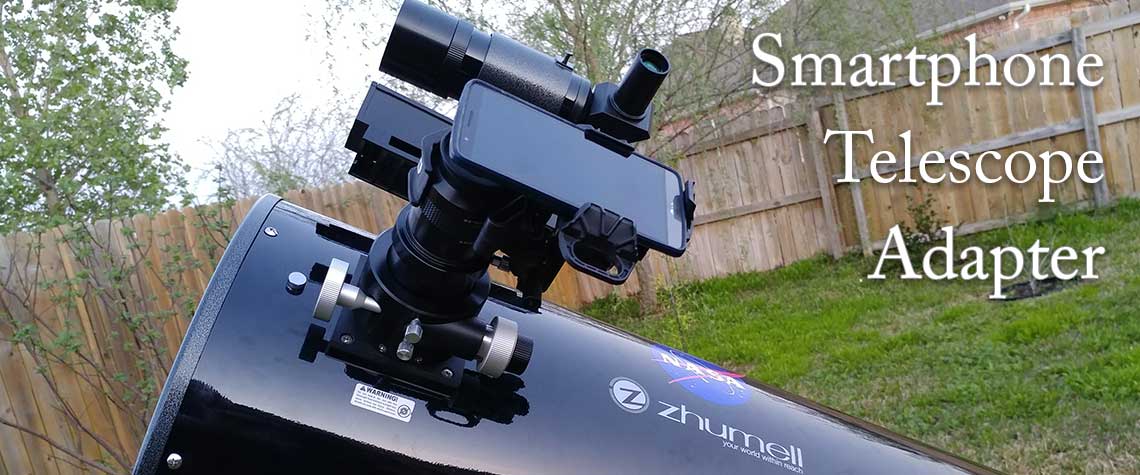
Review: Celestron NexYZ Universal Smartphone Adapter
By Tom Campbell
As many know, I like to do afocal astrophotography using a smartphone. Originally, I would hold the smartphone to the eyepiece, wiggle it around until I got the image in the camera app's viewscreen, try to focus the best I could, and snap the picture. My main telescope is usually a Dobsonian, and since they aren't guided, it is a fine balance of moving the scope to center the object, then moving the camera to get it in the view and take the photo before the object drifted out of the Dob's eyepiece again. Occasionally, I could get a good image, but most of them were blurry or showed nothing at all.
My First Cellphone Attachment
A few years ago, I purchased a GoSky universal smartphone adapter which held a smartphone up to the eyepiece and kept it steady. This removed one of the variables (aligning the phone to the eyepiece) and made taking photos much easier. The adapter I had worked for almost any smartphone, and held the phone to the eyepiece with three rubber-lined strips. The strips were narrow, however, and didn't really accommodate phones with curved backs very well. Unfortunately, my smartphone did have a bit of a curved back, so if the telescope were at certain angles, I had to be very careful that the phone didn't suddenly pop out of the adapter and crash to the ground.
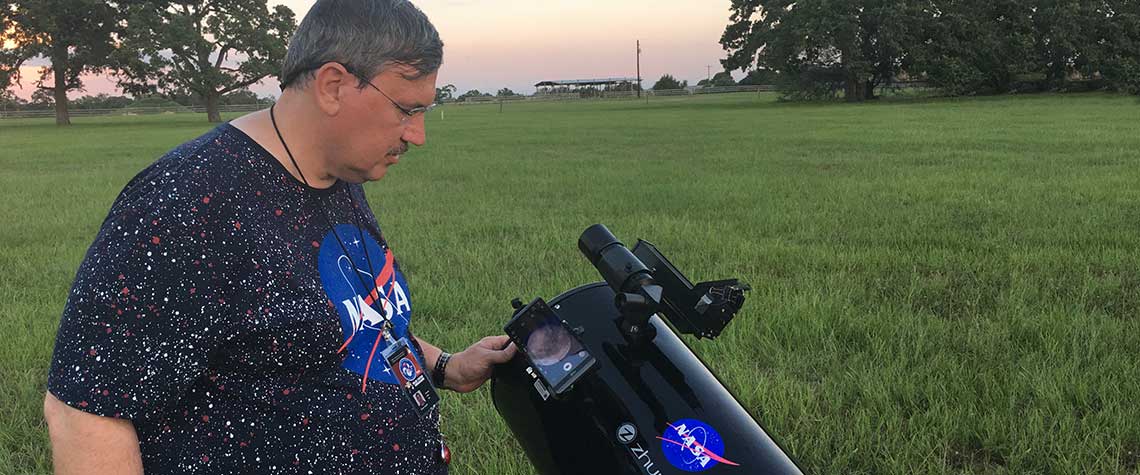
This was my first smartphone adapter and it was useful when I took my telescope to outreach programs where crowds gathered around the telescope.
The other downside to this particular adapter was its limitation to being used by 1.25" or smaller eyepieces. This meant that the only eyepieces I could use it with were those with smaller apparent fields of view. This wasn't a problem for imaging planets or even the Moon, but widefield sky shots were all but impossible.
A few months ago, I saw an ad for the Celestron NexYZ universal smartphone adapter. This one had better phone grips (the gripper bars were plastic instead of metal, but were taller and curved inward, making a better clamp onto the phone. It also would attach to both 1.25" and 2" eyepieces, meaning I could use it for any eyepiece in my collection.
The New Celestron NexYZ
Still, this wasn't enough to push me over the edge in getting one. The price was a hefty $60 for a mostly-plastic gadget that I already had. I felt I could wait awhile to get this one. That is, until one night last November . . .
I had set up the club's 20" Obsession in my driveway. I was still practicing getting it set up and taken down in the dark, so that whenever I took it to darker skies, I wouldn't struggle. It takes me about 15-20 minutes to get it all set up, and by the time I had finished collimating, clouds had started to roll in. The Moon was still uncovered, though, so I thought it would be cool to take some photos of it and compare them to those of my 12" Dob.
The Unfortunate Accident
I slipped my smartphone into the GoSky adapter, popped in an eyepiece and aligned it to my camera lens and then popped the whole contraption into the telescope's focuser and tightened it down. I then swung the Obsession over towards the Moon and in the blink of an eye, my smartphone popped out of the adapter and went crashing to my driveway.
Broken Parts
Horrified, my heart fell into my stomach and I turned on my flashlight and went to see what was left of my phone. The back of the phone had popped off, my phone battery lay several inches away, and my glass screen protector was shattered. After a careful look, there was thankfully no actual damage to the phone. However, if I ever wanted to try taking photos with the Obsession, I was going to need a better adapter.
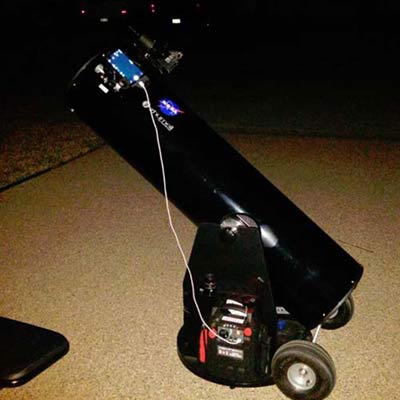
The Celestron NexYZ Universal Smartphone Adapter is attached to the telescope.
The Online Search
I kept looking online and after a week or two, found a sale on the NexYZ on Amazon for $50. I pressed the Checkout button and the adapter was soon on its way.
The Adapter Arrives
Opening the well-packed box revealed the NexYZ. Compared to my previous smartphone adapter, this thing was huge. I immediately wondered whether its sheer size and bulk would cause balancing issues for my telescopes.
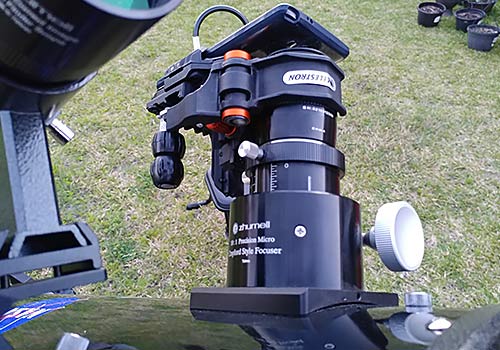
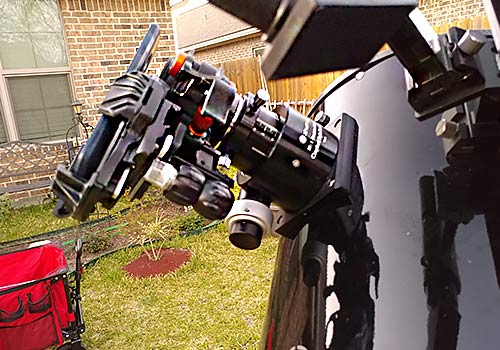
The design itself, however, was pretty clever. There were three adjustment knobs which moved the smartphone platform in relation to the eyepiece clamp. One knob for each of the X, Y and Z axes. This must be how Celestron came up with the name. There was a fourth thumbscrew which, when fully loosened, would allow the eyepiece clamp to open wider and then could be tightened again to ensure a snug fit to the eyepiece. This can be a bit hard to reach when the unit is attached to the telescope, but not impossible.
Also included in the box were a couple of rings that could be fitted over smaller eyepieces (such as microscopes, binoculars, or even the old-style 0.965" eyepieces).
Functionality:
The NexYZ does exactly what it says it does. This adapter is great at holding any smartphone in place. I can put in my smartphone and literally turn the adapter to any angle and the smartphone doesn't budge.
The large size is a bit of a hindrance, however. You may have to put your camera at an odd viewing angle in order to keep the adjustment knobs from bumping into the telescope's focuser knobs. This brings up another possible problem: The torque from a heavy smartphone at an odd angle can cause the eyepiece to begin to unscrew from its barrel. It will only unscrew a little bit (well under half a turn, usually) until it reaches equilibrium with gravity, but it can be a bit disconcerting. In practice, the eyepiece is in no danger of coming completely unscrewed from its barrel (unless it's only barely hanging on to start with) and is merely a minor annoyance.
The X and Y axis knobs are located on the same shaft, one right above the other. The Z axis, which raises or lowers the smartphone above the eyepiece, has its controls on a separate knob on another side of the adapter. If you don't have the eyepiece clamped low enough, as you lower the phone, you may find your smartphone bumping into the eyepiece clamp pivot, which changes its angle a bit.
Quality:
At first, I was a bit disappointed to see so much plastic. Except for the screw mechanisms, the entire adapter is plastic. However, I soon learned that this served a purpose. The plastic helps to keep the adapter as light as possible, which is especially important due to its size. Clamping this on an eyepiece with a smartphone attached can easily shift the balance point of the telescope. The plastic minimizes this as much as possible.
All three axes use simple worm gears to position the phone. They work well enough most of the time, but at certain angles will slip a bit. At times, I've had to hold the gear knob with my hand when taking the photo in order to keep the eyepiece centered in the shot. There are small adjustment screws which will tighten the gears a bit, but then they become difficult to turn at all.
My particular smartphone, an LG V20, has two off-centered cameras. One of them is right at the edge of the adapter's left-right range, so it can be a bit of a problem. Luckily, for most angles, the gear doesn't slip and everything works perfectly.
Adaptability:
While there are a few 2-inch eyepieces that are too big for the NexYZ to get its arms around, there aren't many. Also, it seems equally at home on a refractor or reflector (I didn't get the chance to try it on a catadioptric telescope, but I don't foresee any problems there. In fact, one of its advertising photos shows it attached to a catadioptric scope).
Cost:
The price is a bit on the expensive side, especially considering it is generally a bunch of plastic bits screwed together. However, if you're serious about taking astrophotos with your smartphone, this is the best adapter I've tried. I connect my smartphone to my telescope a lot at outreach events to allow multiple people to “see through the eyepiece” at the same time, so it is worth the cost to me.
Overall:
In general, I'm quite pleased with the Celestron NexYZ. It has a few quirks, but it does its job effectively and I feel safe leaving the smartphone in the cradle while I slew to a new object.
It usually takes me a few minutes to get the phone properly centered over each eyepiece and ready to snap photos. For this reason, I try to limit eyepiece swapping as much as possible during the evening. For outreach events, this also makes it impractical to allow visitors to use the adapter to take photos with their own phone unless you have a short and patient line at your telescope.
To make sure everything is aligned properly in the dark, I will make the Moon my first target, if it's available. It's big and bright and easy to find and focus on. Failing that, I will shine a flashlight down the tube of the telescope. It will appear as a bright unfocused circle of light to the camera. Once you have that circle centered as well as possible, you know you are aligned and can then take aim at whatever target you wish.
In summary, if you are interested in doing some afocal astrophotography with your smartphone, you can save a lot of frustration and wasted time by getting an adapter. And if you're going to get an adapter, this is currently the best one I've seen.